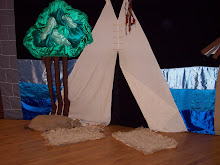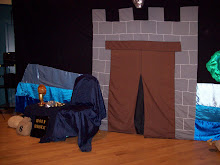"I really enjoyed this presentation type play. I have never been big into history and I do know the story and the basic concept of what this play illustrated, but I have never actually seen it acted out in such a way. I fully agree and support their idea that if everyone can see, and try to relive the past for a moment, maybe that can bring hope and light to the future."
"I learned probably the most in the question and answer portion of the evening when Carla was talking about the white people returning to nature and getting back to the core of our origins. I was really struck. I never have realized exactly how much we have strayed from what is true and real in that sense, turning to a love for power and money and letting that drive us when really, as she illustrated by removing the silver mask and replacing the wreath of flowers, returning to nature and our roots is what can and will get us back on track. I loved this."
"I also really liked the way Carla spoke about Jesus and the cross through this entire production. I suppose it was not just specifically Carla, but all three of them making the distinction that the cross did not represent Jesus's love, but rather the slavery and oppression that was brought through that religion. It was through Christianity that they justified slavery and I really did not know that before. I really like when Carla said that like Jesus if we can live through and experience the pain of our ancestors and the past, then together we can spread love and do great things. I think that is remarkable and I've never thought or it has never been brought to my attention this idea."
"One last thing that I really was taken aback by was when Djalòki was describing the origin of Creole, he said it was a language that came from a time of suffering and resistance. When he told the stories about how they put all the people together so that they could not communicate, but then rising above this and working it out to form Creole, the way in which he told it was beautiful. You could feel when he spoke, his intense love and passion for all of this.
I learned a lot! I knew basically none of this and was absolutely blown away by this performance and the question / answer time after."
"I learned probably the most in the question and answer portion of the evening when Carla was talking about the white people returning to nature and getting back to the core of our origins. I was really struck. I never have realized exactly how much we have strayed from what is true and real in that sense, turning to a love for power and money and letting that drive us when really, as she illustrated by removing the silver mask and replacing the wreath of flowers, returning to nature and our roots is what can and will get us back on track. I loved this."
"I also really liked the way Carla spoke about Jesus and the cross through this entire production. I suppose it was not just specifically Carla, but all three of them making the distinction that the cross did not represent Jesus's love, but rather the slavery and oppression that was brought through that religion. It was through Christianity that they justified slavery and I really did not know that before. I really like when Carla said that like Jesus if we can live through and experience the pain of our ancestors and the past, then together we can spread love and do great things. I think that is remarkable and I've never thought or it has never been brought to my attention this idea."
"One last thing that I really was taken aback by was when Djalòki was describing the origin of Creole, he said it was a language that came from a time of suffering and resistance. When he told the stories about how they put all the people together so that they could not communicate, but then rising above this and working it out to form Creole, the way in which he told it was beautiful. You could feel when he spoke, his intense love and passion for all of this.
I learned a lot! I knew basically none of this and was absolutely blown away by this performance and the question / answer time after."














